Where do the separated rare earths produced by Lynas actually go?
The development and financing of new Australian rare earth projects continues to be plagued by difficulties in securing binding offtake agreements with future customers.
We think that a big reason for this relates to a gap between perception and reality.
The perception is that the USA will be a big new market for rare earths.
The reality, as I shall demonstrate, is different. The USA is a (very) minor player.
Piercing the veil of secrecy of National Security propaganda
The problem, for you, me, everybody, is that there are powerful forces at work arguing to the contrary, promoting a course of action in national policy that is at variance with reality. I cannot change the thinking of our government. Their commitment to the maintenance of public fiction is, by now, very clear.
However, I can promote attention to the evidence.
What matters to grow the Australian Critical Minerals industry is finding the paying customer.
If you have no customer, then you have no business.
This leads me to wonder why this message has been effectively blocked.
I mentioned that ugly word propaganda. This is the dissemination of misinformation for the purpose of shaping public opinion towards a government policy objective.
It should be rather obvious, to anybody who does not live under a rock, that the global critical minerals policy initiatives emanating from the USA, Australia, Japan and Europe are united behind one common goal.
Current Western critical minerals policy initiatives are united behind the goal of reducing our collective reliance on China as a source of critical minerals.
I have no quarrel with the idea that supply chains might be better diversified.
There is only one problem. The minerals are where they are and won't move magically to a different location. Equally, the smelters and processing plants are where they are, and we cannot sell to new customers if they don't exist to buy the product.
The crux of the matter is that Australia is doing a great job of finding critical mineral deposits. The problem is that Western firms are not lining up to buy them.
The killer issue for government policy makers is that no amount of propaganda can magic up a non-existent buyer. The buyers are the people with money to buy product. Where are they?
The public policy imperative is to find where the real buyers are.
In a previous wire, Which country is the largest exporter of unseparated rare earth concentrates to China? we used public US Geological Survey Data, and public SEC disclosures from US miner MP Materials NASDAQ: MP to show that 100% of US mined rare earths go to China, to be separated and refined, metallized, and returned to the USA as magnets.
Evidently, the USA is not a big buyer. Perhaps they will be one day. However, that will not get a mine constructed today. Mining investors need confidence on where the buyers are today.
If public policy does not change soon, then investor confidence will fade.
There is a great story to be told with Australian Critical Minerals, but if we do not focus on where the real buyers are found, it will become a nightmare story of woe and not a cheery story of how we built a new growth industry.
Tracking shipments through public trade data
In this note, we follow the same guiding principle. Due to the (frankly) insane levels of propaganda, we shall use public sources to demonstrate the likely destination of the refined products from the Lynas Advanced Materials Plant (LAMP), in Malaysia.
While Lynas (ASX: LYC) does not publicly disclose where their product goes, we can make a fair statistical estimate from public trade data which shows where most shipments go.
In the case of the USA, where US Customs Maritime Shipping Data is publicly available, via the Bills of Lading that are filed with customs officials, we can oftentimes follow shipments in some detail, and confirm the ultimate customer for the product.
Just to prove the point, we will show you some actual records of shipped product.
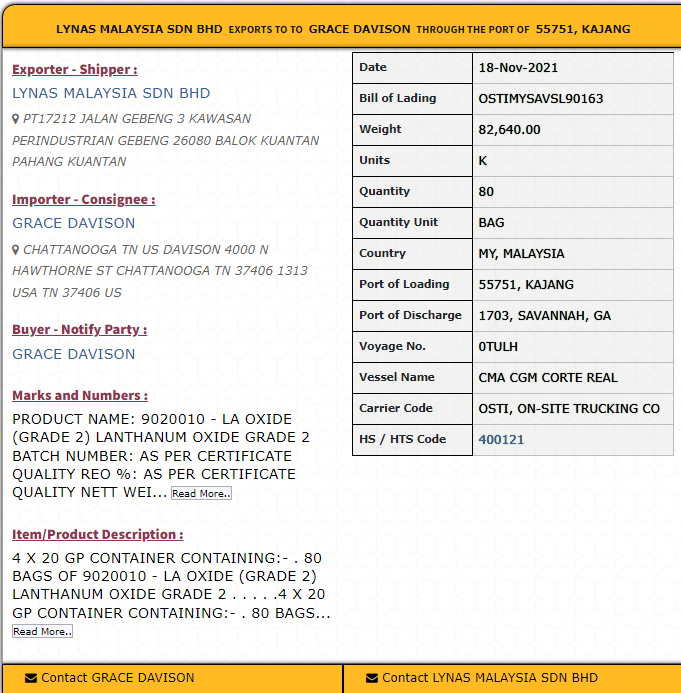
That is a public Bill of Lading record from US Imports, one of many global data providers that provides searchable public records of US Maritime Trade.
Australians may be a little shocked by this level of public disclosure.
However, the United States of America has a robust participatory democracy where it is usually possible to find out what you want to know by asking the right people.
From that disclosure we can learn a lot. The finished Lynas product from their LAMP plant up in Malaysia, is typically shipped in standard 20-foot containers, in one tonne bags. You can fit 20 bags in each container, and so you need to ship four containers to move 80 tonnes.
Lynas would probably be unhappy with me now if I went and documented all their US based customers. I can tell you that the main buyers of lanthanum and cerium product in the USA comprise a selection of non-household names who make FCC catalyst for oil refining.
There is no great surprise there. Lynas say as much in some of their market disclosures.
However, I will note the following key points.
- You cannot easily do this for Australian trade data because the records are not public.
- The openness of US trade data does not apply to Australia due to government secrecy.
- Australian democracy may not be as robust as US democracy in respect of disclosure.
None of that will make the Australian government happy, but I don't care about them.
What matters is finding where the buyers of minerals product are, so that projects can secure offtake, get financed, hire people, build stuff, and get into production.
Whenever the Australian government is opposed to business and industry, you may rest assured that I will be publicly and vocally opposed to them.
I am an investor. I care that the companies I invest in will be successful.
How secretive is the Australian Government on trade data?
There are commercial sensitivities that attach to knowing precisely where trade originated and with whom any party has traded. I understand that. However, when you are trying to build new industries, it really helps to know where a start-up might find a buyer. This is no doubt why the USA happily allows for the collation and dissemination of public trade records.
There are pluses and minuses to this equation.
Any single US domiciled firm knows that, unless they make a special request, their trade data will be available publicly through any one of many data services. This means that competitors can easily research their suppliers. However, it also means that potential suppliers who are outside the USA can readily locate potential buyers. What goes around, comes around.
The worst thing that can happen to any new business is not finding buyers.
With this observation in mind, we need to examine the layers of secrecy for Australian public data disclosures. It may shock you to know that our society is murky. You can do a better job sourcing information about trade in and out of China, than in and out of Australia.
The reason for this is law, as outlined by the Australian Bureau of Statistics (ABS):
By law, the ABS must disseminate official statistics while making sure that information is not released in a way that is likely to enable individuals or organisations to be identified.
Sadly, for our study of rare earths trade, this makes Australian trade statistics useless. The data appears to have been confidentialised according to ABS guidelines.
Confidentiality applies whenever there is a chance you might identify an individual firm from the trade data. This is so when there is only one firm operating. For most of the past ten years there was only one firm exporting rare earth concentrate, and that firm was Lynas. Therefore, the trade data is confidential, and permanently so.
You might think that this situation is more than a little foolish.
More than fifteen years ago, an individual by the name of Frank Bingham, who then worked for the Department of Foreign Affairs and Trade (DFAT) documented the full comedy. His guide is a model of analytical rigour, combined with a quiet refusal to accept garbage as data. I think I would have liked Frank.
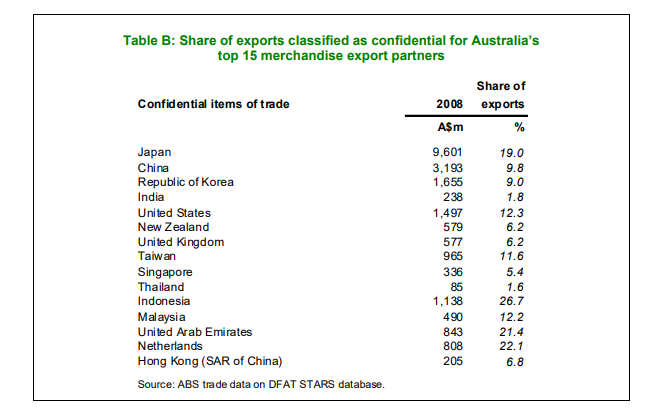
Needless to say, this is one of those Australian Public Service travesties that seems like it will never change. It is all down to The Census and Statistics Act 1905
The ABS has a legal obligation to ensure that confidential data are not released. The Census and Statistics Act 1905 sets out the rules governing the collection and dissemination of statistics undertaken by the ABS. The Act provides strong protection for the confidentiality of information supplied to the ABS.
This confidentiality of trade applies whenever there is an effective trade monopoly, in that the party to trade is clearly identifiable as the only party trading in that product.
Due to a 1905 law, Australian trading monopolies enjoy protected status.
You, me, everybody, are not allowed to know how much they are trading, or its value.
Progressive, huh?
Fortunately, as Frank Bingham first documented, you can get around this problem by taking other sources of public information. These are things like royalty data, and foreign data. This will be our approach to answer the burning question which our government is silent on.
How large is the Australia-USA rare earth trading opportunity?
Let's build to the surprisingly comprehensive answer, by stages.
What can we learn from Lynas public disclosures?
I am not even going to bother showing readers how to get non-existent trade data out of Australian government sources. You might try going to the UN Comtrade database, but Australian secret squirrel behavior applies to that source also. It is blank for rare earths. In short, Australia is a total bust for obtaining useful data on our rare earth supply chain.
However, we do know that the supply chain for Lynas rare earths begins at Mt Weld, where ore is mined and beneficiated, to be shipped as concentrate, in containers, out of the Western Australian Port of Fremantle to the Malaysian Port of Kuantan.
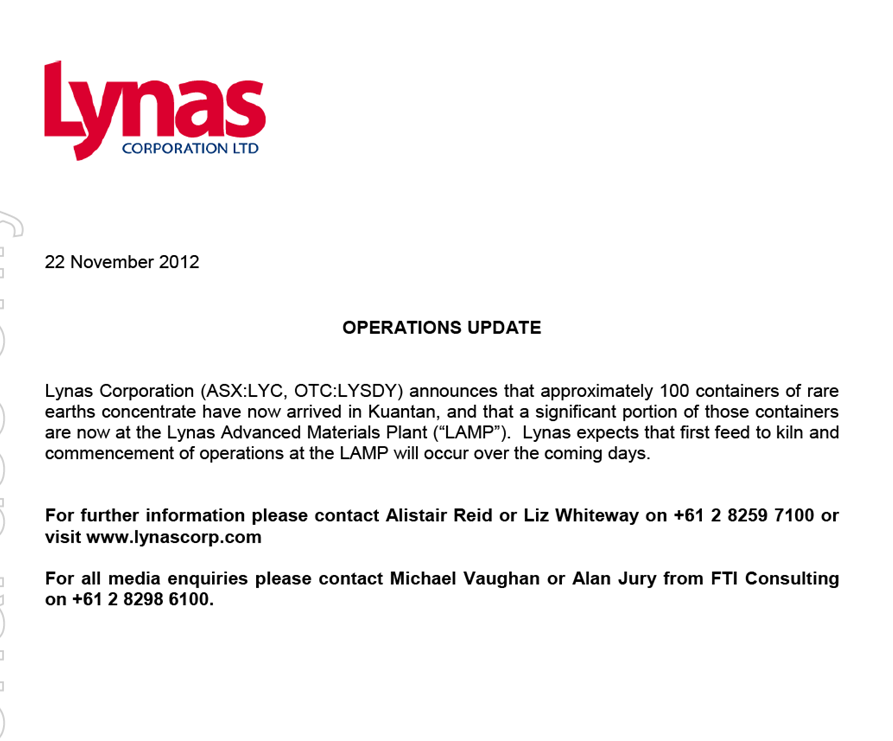
If this were the USA, we could hop over to the Bill of Lading database, and work out the weight of the cargo, and so estimate how much contained rare earth oxide was delivered to LAMP.
However, this is Australia, so that information is all super-secret. On pain of death, we cannot tell you. After all, you could be Chinese, or far worse, you might work for Iluka!
Luckily for you, dear reader, espionage is my middle name.
The disclosure does not tell us the weight of the containers, but there are known container weight limitations for 20-foot GP containers at 22T tare. There is no advantage to shipping larger containers, as the 40-foot GP containers are rated a maximum of 20.5T tare in WA.
Lynas is not all that secretive. I am sure Amanda Lacaze would happily tell me all of this. There is no point in me bothering her. She is doing a great job. Leave her be.
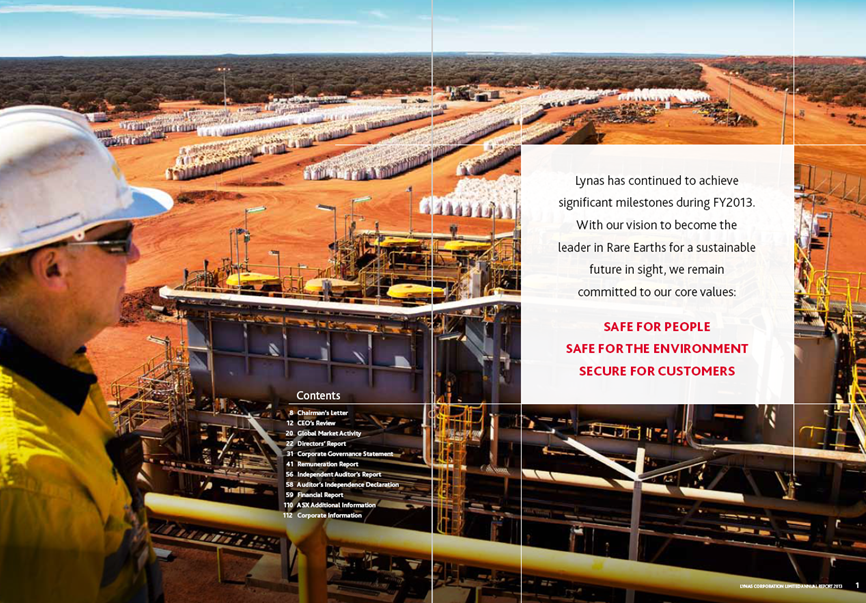
Corporate disclosure only needs to go so far. Crazy people could fly a drone over Mt Weld and count the number of 2,800 kg rare earth concentrate bags lying about the place in inventory.
It would not be a terrible thing if we all knew what I will now state:
- Lynas runs a concentrate plant with 66,000 tpa nameplate capacity.
- The concentrate grades at around 35-40% contained REO.
- The shipping rate for containers ex-Fremantle is around 200-250 per year.
That information is all derived from analysis of Lynas public disclosures to investors. You can do better from the concentrate inventory disclosures in the early annual reports when the LAMP plant was first getting going. For instance, the Q4FY2014 disclosure reads:
At the end of the quarter 10828 dry tonnes of concentrate containing 4144 tonnes of REO were bagged for export.
Operationally, they produced a concentrate that graded 4144/10828 = 38.27% REO. Suppose we run that plant at 90% utilization, to produce a 38.3% concentrate for an ore which grades at 24.04% NdPr, according to the mineral resource estimate. That is enough to generate around 59,400 tpa of concentrate containing 22,750 tpa REO and 5,500 tpa NdPr.
Nothing happens by accident when mining is done properly. The name plate capacity of the concentrate plant produces enough material to feed a 22,000 tpa plant up in Malaysia. The concentrate is shipped in 2,800 kg bags, within 20-foot GP containers.
You can do the math and work out the port movements.
You can fit 7 or 8 bags in a container. You need to ship about 21,000 bags a year, or around 2,700 containers per year, which is a run rate of an average 225 containers per month.
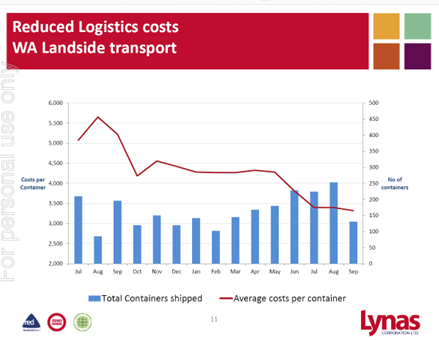
During the start-up ramp of production Lynas was very focused on operating efficiencies for cost reduction and so they made some disclosures of container movements. During this period, the plant was operating at about 60% capacity, so our estimates seem right.
Since we really only care where the ultimate product goes, it is enough to know approximately how much material ought to be showing up in Malaysia. We will use the import data, and this rough estimate of container movements to firm up whether the trade data makes sense.
Let's go to Malaysia to figure out what happened in Australia!
In principle. you could look at FOB trade ex-Australia enroute to Malaysia to nail how much concentrate Lynas was shipping to the LAMP plant. We saw that you can estimate this from knowing the plant specifications, and some basics about WA road freight regulations.
However, the Australian trade data is dark, so we have to look at Malaysian trade data to work out what was coming in. We don't really care about that very much but want to check that the data in Malaysia is sensible. Our key interest is the export data for finished product. Using the import material flow rate estimates, we can at least see if things make sense.
Up to a point, they do. However, first we need an explainer on trade data.
Global trade reporting is largely standardized about the reporting of quantity and value for all traded goods under the Harmonized System (HS) for customs codes. This changes from time to time and is often reported in different levels of detail. The system we use is the HS6 code, that is the common denominator for most international trade reporting. Places like the USA and China often report in greater detail than this, which is useful for tracing rare earths.
However, the UN Comtrade database only supplies HS6 codes.
For rare earths, the two that matter are:
280530: Rare earth metals, scandium and yttrium, whether or not intermixed or interalloyed.
284690: Compounds, inorganic or organic, of rare-earth metals, of yttrium or of scandium or of mixtures of these metals.
I looked those up at the Australian Free Trade Agreement Portal. You can use that to find out which HS Code to look up in the Australian trade database so you can get nothing back!
Let's not bother with 284690 for now, as that covers refined rare earths.
Let's hop over to UN Comtrade and look up 280530 with Malaysia as the reporting country.
Due to the Australian secret squirrel data police, we have to look at this as imports to Malaysia since the official exports from Australia disappeared into the Canberra bureaucrat black hole.
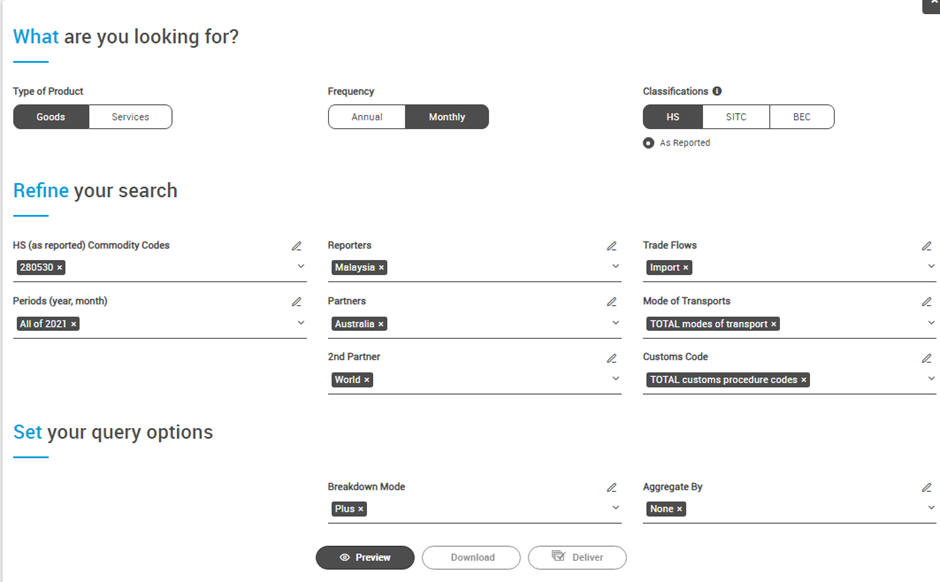
The above panel shows the appropriate search settings to get monthly data on rare earths that were imported to Malaysia from Australia. Note that the UN data release is delayed, so you can only get data up to 2021. If you look for exports from Australia to Malaysia, you get nothing.
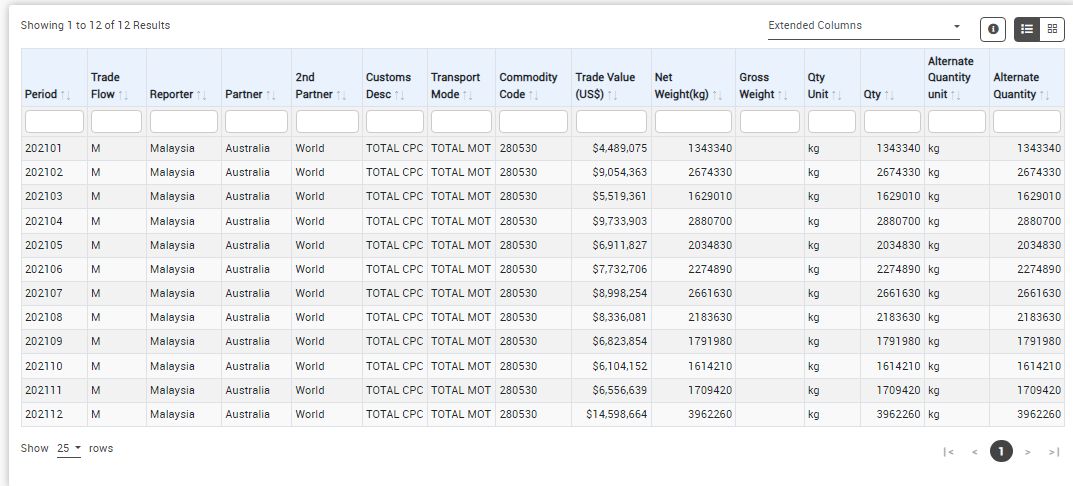
What the Australian government hides the Malaysian government reveals!
Here we have both the customs value and quantity of rare earth concentrate by month.
Witness the delicious irony of government secrecy in action.
Remember, that only applies if your company could be identified from the trade data alone. Due to official Australian government policy enforcing this secrecy we now know that:
- This has to be Lynas because the Australian data on exports is officially dark.
- We also know the customs value and weight of each shipment by landed month.
Lynas did not disclose that, but the workings of Australian government data censorship did!
Let's now do another simple check using that Lynas operations update from 22-Nov-2012. It said that approximately 100 containers had arrived in November, being the first shipment.

If you divide 2,116,299 kg by 100 you get 21,163 kg or just under 22 tonnes. Remember that this is the tare weight cargo capacity of a standard 20-foot GP container, such as might travel on WA roads from Laverton to the Port of Fremantle.
We also know that the raw concentrate had a customs value of US $ 2.87/kg. This seems low until you remember that the concentrate is only 38% REO content and is unseparated. You could perhaps track royalties at the WA Ad Valorem rate of 5% and work all of that out.
We are done here. This is not why we looked at the data, and we think Lynas disclosures are more than adequate on this front. Our purpose is to check if the trade data makes sense.
This is probably a bit shocking to anybody who reads Australian newspapers, but it is possible to figure stuff out from public data sources, especially if you can find a government, even a foreign one, that does not actively conceal and hide the relevant information.
Thank you, Malaysia!
At least somebody is upfront and honest in the global rare earth trade!
Now let's look at exports from Malaysia for finished products
There is a small timing glitch in that first shipment record. It shows up in December in the data even though Lynas disclosed that it had arrived as at 22-Nov-12. This is condition normal with any usage of trade data. There are always timing gaps on recognition and sea voyages.
Exports clearly happen before imports, but the value of the items recoded will be different, due to the convention that exports are generally recorded as Free on Board (FOB), while the imports are recorded as Cost, Insurance and Freight (CIF). There are also differences on the dutiable value of goods, versus their invoiced value, and so on.
We cannot put too much emphasis on trade data as a golden record of truth in what went where and when. For one thing, a shipper may not use the correct HS Code. You may be counting exports of apples that were mislabeled as oranges. Stuff does happen.
However, our goal is to make sense of previous public disclosures from Lynas.
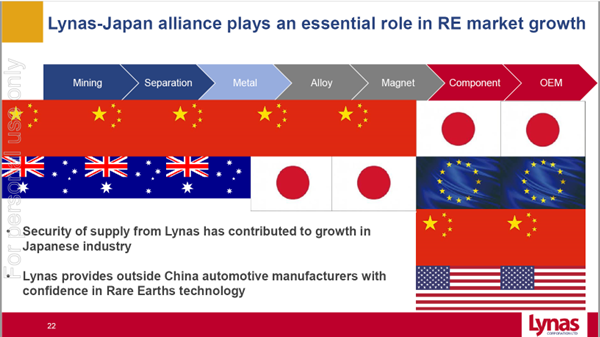
The rhetoric of this time is all about the ex-China supply chain, and the need for producers to de-risk their operations by selling to buyers outside of China. This is all great politics, but the rare earth supply chain is about 90% China in downstream magnet applications.
Call me crazy, but if 90% of the high-value downstream market is in China, then it is a simple mathematical consequence that the ex-China market is 1/9th of that, or 10% of total. If you present me with a business plan to target 1/10th of the total addressable opportunity, folks like me will listen politely, but are liable to choke on our canapes if you say this reduces risk.
Let me be crystal clear about the message from this investor:
Purposefully limiting your end market reduces competitive deal tension on selling your final product, limits your growth opportunity, your sources of financing, and your operational flexibility. It just adds to business risk.
I know that today up is down, the sky is red, the sea is green, and the grass is bluer over there than here. I also know that governments actively conceal trade data and seem disinclined to frame industry policy around the hard facts before us and not some convenient fiction.
The trouble with this emerging policy picture is that investment is a voluntary exercise.
People like me, who deploy capital, are not going to do so if the business plan involves a wing and a prayer on the buyer being there.
If there is no clear buyer, there will be no investment.
With that out of the way, let's reveal where the Malaysian trade data shows the Lynas buyers to be located, as the first port of call, for where finished rare earth products are shipped.
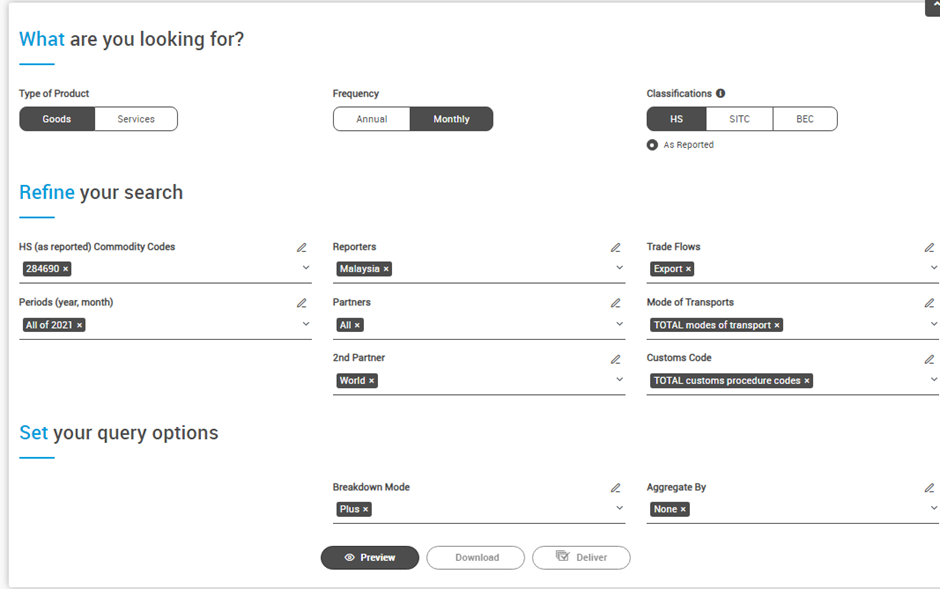
People who work in financial markets are not like people who work in think tanks. We are not satisfied with political rhetoric, or public scare campaigns. What we care about is whether or not the companies we invest in have regular and diverse buyers for their products.
From the following five pages of reported monthly trade data for the Lynas LAMP plant up in Malaysia, we can be satisfied that the firm has plenty of diverse buyers for their products.
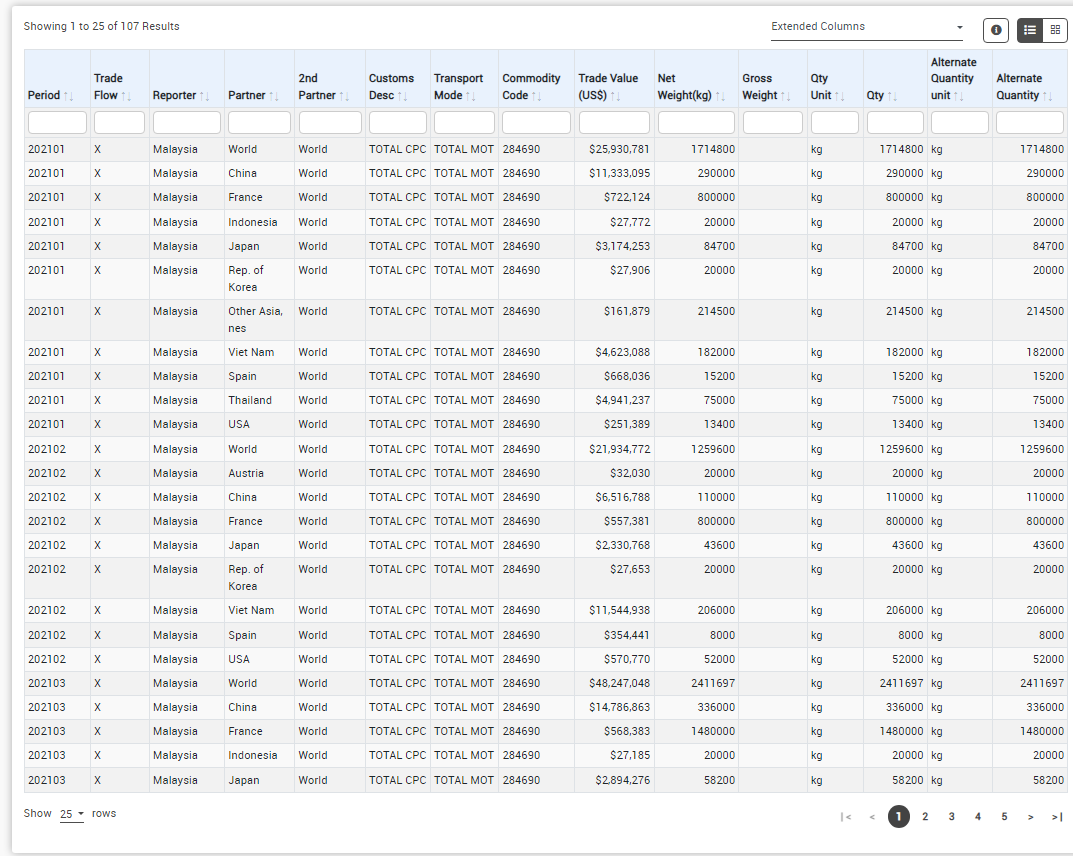
Before we show estimates of the Lynas LAMP global product sales distribution, it is important to sense check the aggregate value of Lynas reported $A sales of finished product versus the UN Comtrade aggregate value of exported product. This is in $US so we need to adjust for currency conversion and note that exports are conventionally Free on Board (FOB).
Since we are translating at average annual FX rates, we do not expect these to fully match, but they are close enough to lend confidence to the use of these estimates to get shipped shares.
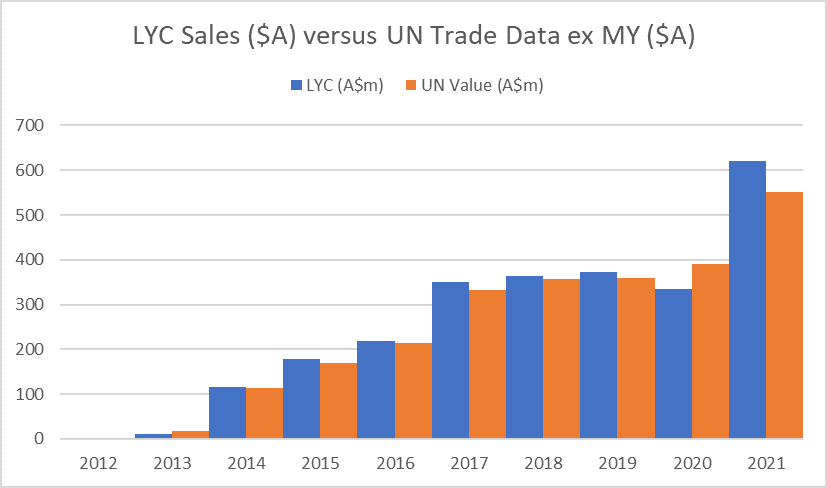
There is only one producing plant for HS Code 284690 product in Malaysia. There may cargoes that are transshipped or imported and reexported under this code. Therefore, it is important to have a look and see if the data broadly match, over time, which they do.
Note that the major discrepancies appear in calendar 2020 and 2021 (we do not have any data later than that), during which exchange rates (especially AUDUSD) were quite volatile. There is no reason to expect these will line up precisely, and they don't. If they did, we should worry.
Our estimates for the average global market share of shipped product
Okay, that was a heap of work to get this far. Remember we needed to trace the supply chain step by step from the Mt Weld mine, through the plant specifications of concentrate, to the shipping method and expected trade volume, and on to the Malaysian import data.
That set us up to be confident that we are seeing the proper import data series going into the LAMP Plant at Gebeng in Malaysia. Out the other side we know the Lynas reported sales and product volumes. These broadly check out with the Malaysian reported export value and the reported export volume. Malaysia is not as transparent as China. If we were using the China Customs Data, we could go to HS Code Level 8, and track the exact rare earth product.
The USA and China are generally the most transparent countries in this respect.
Malaysia adheres to the de-facto global standard and reports quantity and value at HS Code 6 level to the UN, which we can pick up through the UN Comtrade database. Australia does not show up at HS Code 6, or any level, because they censored the data. This means that any international investor must do all the work I just did to figure out the supply chain.
Needless to say, such opacity in Australian government dealings raises the cost of capital. It makes it harder for developers to secure offtake and persuade financiers that there will be sufficient product demand.
Opacity simply increases financing risk.
However, Lynas does come through this wash and rinse cycle smelling of daisies.
Plenty to see here, but nothing to worry about. It all lines up with expectations, in spite of our government systematically attempting to hide or obscure every key linking data item.
They can cop a helpful blast from me if they ever get in my way :-)
Now to the important result, where I have included HS Code 284690 and the HS Code 284610 for some classes of cerium product. That pretty much covers the bases since there are no magnets or other finished items coming out of Lynas LAMP, such as we know it today.
The Lynas production ramp, and customer development, was mostly complete by 2015, so we average both the quantity (kg) and value ($US), by customer shipped destination, over seven full years from 2015 through 2021. This provides a useful sense check on the numbers.
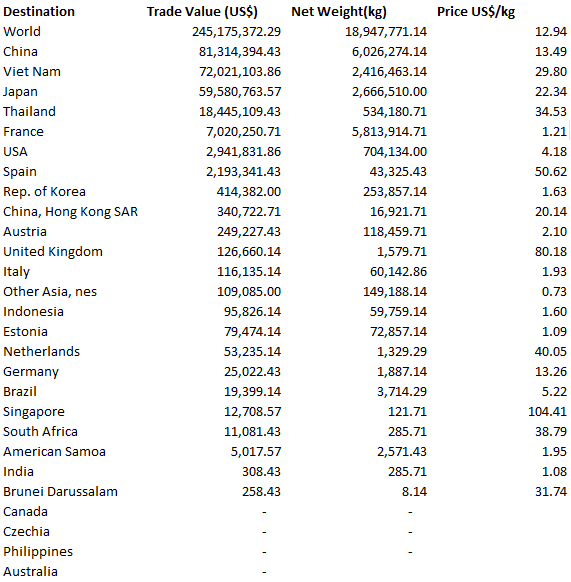
Note that these are estimates from Malaysian trade data.
These are not official Lynas numbers, and I am happy to stand corrected if they represent a material misstatement of the company sales mix.
I am not doing this specifically to pick a bone of contention with Lynas.
The reason I am doing this is to make a key point about the global rare earths market.
When viewed by trade shipment destination, China is the largest run-rate target for rare earths finished products. This does not mean that the customer is Chinese.
There are many Japanese firms with backward integrated operations in China.
The Japanese are comfortable owning and operating magnet factories in China.
I have also included a US$/kg measure of average product price. You can see that the higher unit value markets are Vietnam, Japan, Thailand, Spain and the United Kingdom.
People who know the rare earth market might well take a guess and say the United Kingdom is the metals plant run by Less Common Metals (LCM). The low unit value material headed for France is probably the original Rhodia offtake, now assumed by Solvay. The 700,000 tonnes a year of sub US$10/kg material is cerium and lanthanum carbonate that gets bought by a slew of FCC catalyst firms. They are G.E. Chaplin Inc, Grace Davison, Harrop Industries, Blue Line Corporation, and some others. If you spot me a subscription to Panjiva I can get you the shipping consignment details, including the exact dates, ships and product weights.
I can also tell you that if you are not Lynas, and are struggling to offload your cheap cerium and lanthanum products, then you may want to talk to W.R. Grace & Co, and the Pacific Industrial Development Corporation, in the hope of stealing market share from China Northern Rare Earth Group. Jus' saying... Is not research wonderful in the hands of those who can do it?
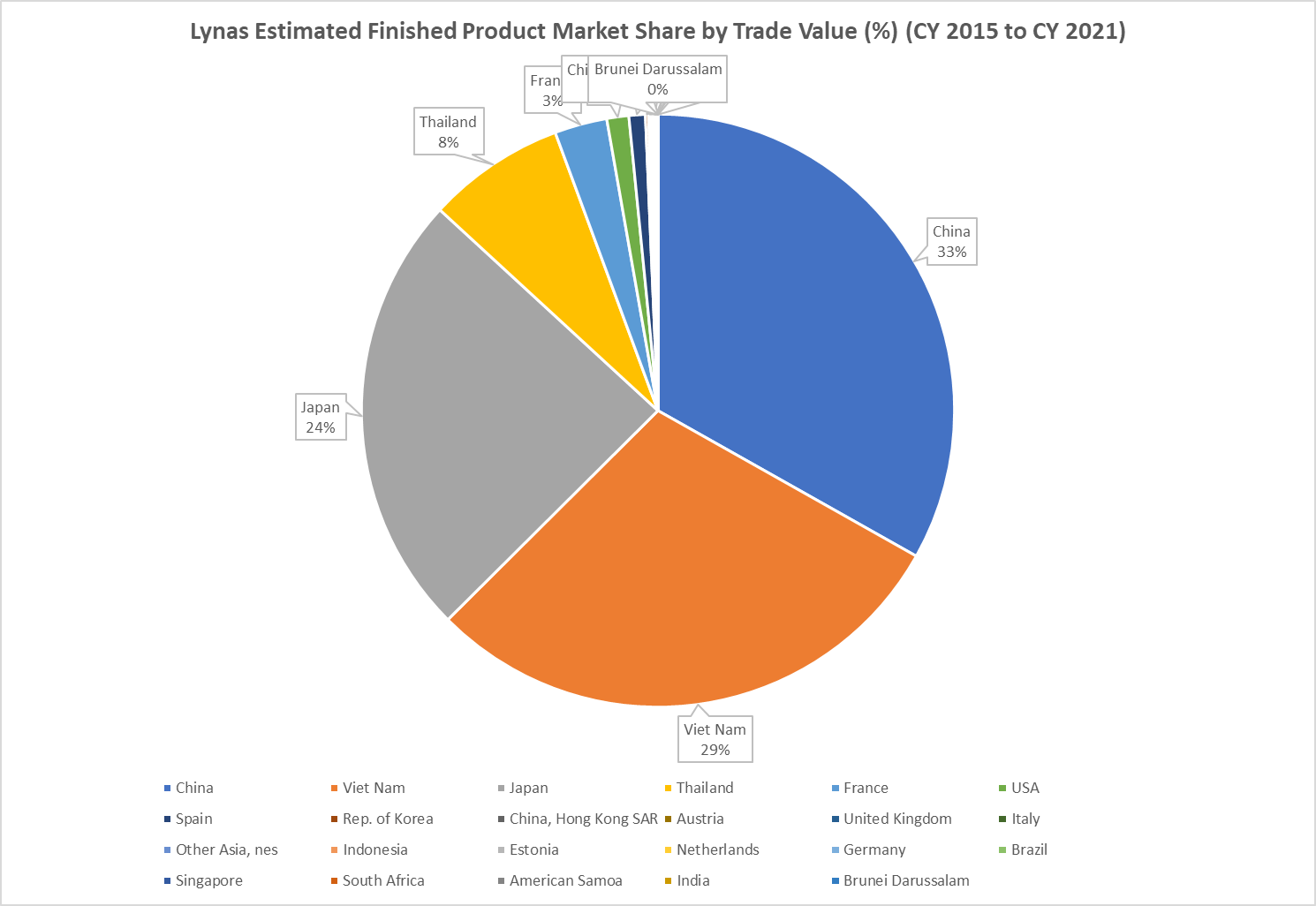
There is a very good reason why Lynas celebrated their early win with Rhodia for an offtake deal shipping product into France. You can see it clearly in the rankings by weight.
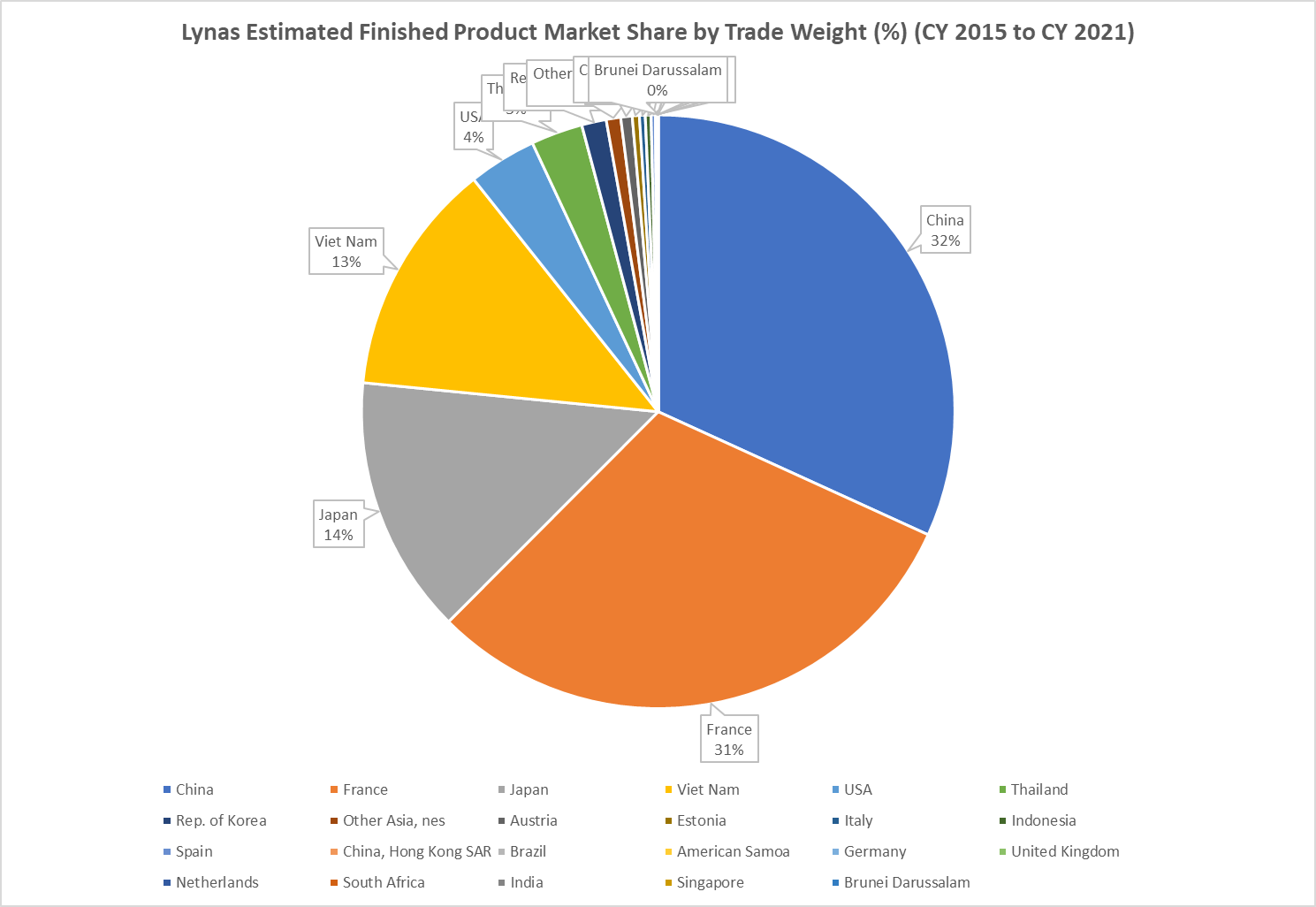
That outsize chunk of material going to France is the lanthanum and cerium products that are used in the European automotive catalyst industry. The same dynamic appears for the USA. The Ce/La stuff comes in great volume and is hard to place. Lynas has a friend in France.
Merci beaucoup et vive la France!
The rare earth market we hear all the think tank noise about is the USA. They are 3.7% of sales by weight, but only 1.2% by value. The current Lynas CEO, Amanda Lacaze has done a deeply excellent job of channeling the US concerns on critical minerals into concrete subsidies.
Lynas has had its US government funding more than doubled as the Biden administration accelerates its mission to secure supplies of rare earths.
That was the glorious headline published by Peter Ker in the AFR on 1-Aug-2023.
I may make fun of think tanks, but this is top work by CEO Amanda Lacaze.
In sales terms, this is what you might call stellar conversion.
You turn a US $2.9M a year run rate country, that represents 1.2% of sales, into a US $300M source of free money, and future sales in strategic heavy rare earths. In the past, I said that Amanda Lacaze is one of my favorite CEOs.
You just cannot fault such a performance on turning ambient noise into opportunity.
Way to go Amanda!
Please forgive me for showing readers where the money is printed.
Investment Conclusion
Never put any money into a think tank. They don't know what is really going on, their powers of research seem pretty limited, and they most likely cannot even spell the word e-s-p-i-o-n-a-g-e much less ever do any of it to save their own skins.
We all get for free what the US State Department pays for.
While the think tank noise is all about the USA, the real commercial action is in Vietnam.
Some Australian firms have clearly figured this out.
Blackstone Minerals ASX: BSX and Australian Strategic Materials ASX: ASM recently announced a three-way MoU for a fully integrated rare earth mine-to-metals value chain in Vietnam.
Blackstone Minerals has signed a memorandum of understanding (MoU) with Vietnam Rare Earths (VTRE) and critical metals producer Australian Strategic Materials (ASM) to develop a fully integrated rare earth mine-to-metals value chain in Vietnam.
Clearly, some Australian mining firms have done their homework.
They did not go to Washington D.C. to waste their precious Steak and Pétrus money lobbying US Congress people who need to be shown a map of Austria.
They went to Vietnam, had some nice spicy food, and spoke to the non-China aligned Vietnam Rare Earths (VTRE). That is inspired commercial sense.

Others, like Ionic Rare Earths ASX: IXR have noted the existence of Less Common Metals, in the United Kingdom, and set up shop in Belfast, Northern Ireland, UK.
Ionic recently inked a deal with Ford for their Belfast magnet recycling venture.
Earlier, I expressed concern that Lynas may be locked in a market share battle with US based MP Materials NASDAQ: MP as they duked it out fighting for share in the limited ex-China market. Now that I know Lynas's sales are anchored by a 33% market share by value headed to China, I feel that they are secure. If push came to shove, they can easily up that market share, so I am happy.
This speaks to the real meaning of risk management. If World War III should break out, nobody should worry about their shares. Whatever happens then, we are all screwed.
Equally, in peace time it makes little sense to fret over the military potential of rare earths. The military is not a big source of demand. If you diverted 2% of commercial use, you are covered. Killing the 98% of opportunity to cover the 2% makes no sense, in any frame of reference.
This is NOT Plutonium that we are talking about. You can make electric vehicles without any rare earths at all, which is what Tesla is contemplating, for future models.
Furthermore, it is not like trade with China is useless. This is all ancient history now but the design for the present Lynas LAMP plant originated in China. The 2006 Behre Dolbear Independent Technical Review, dated 29-May-2006, lays out the history of the original LAMP plant design, and the Chinese Design Institutes that were involved.
The subsequent news release from 19-Oct-2006, explains why Lynas moved it to Malaysia. This was a rational exercise in risk management to escape potential tariff barriers to export of the finished rare earth product. While the design was not fully constructed until 2013, and did evolve over time, the original cracking and Solvent Extraction (SX) circuits are reflective of the accumulation of expertise in the Chinese rare earth industry.
This may not be fashionable to admit today, but that is what actually happened.
Now Lynas is in possession of ten years of accumulated plant management and operational experience in producing rare earths to the exacting purity standards of global markets. When viewed from a distance, this was a successful technology transfer from China to a new entrant in the West. China did not prevent export of that technology and know-how. Now they probably would, which makes the Lynas expertise even more valuable.
For these, and other reasons, we continue to rate Lynas as a long-term strategic holding. There are still some moving parts to navigate with the escalating cost of the Kalgoorlie cracking and leaching plant now under construction. Furthermore, the near-term outlook for rare earths is soft. However, once China domestic EV demand picks up, we expect firmer conditions.
Keep a close eye on Lynas for accumulation around these levels.
Perhaps the optimum window is first quarter of 2024, but we think there is clear value.
This is a great Australian story of industry development. If we can learn the right policy lessons to refocus attention on growing markets for critical minerals in Asia, the future is assured.
The Geopolitical Scorecard
Since the US based MP Materials sells 100% of their products to China and Lynas only sells around 33% of theirs to China (not fact - just our trade-data based estimate), I am happy to conclude that Lynas is 67% better in the geopolitical sweepstakes.
That is an estimate. I am happy to be corrected by acquaintance with the facts, should we ever know them. Short of loading the tranquilizer gun with Sodium Pentothal, we won't get those. Set an ABS Secret Squirrel trap. Wait.
Since the USA accounts for an entire 1.1% of the value of Lynas annual sales, we could happily de-risk the current Australian rare earth industry by only selling to the USA. Our industry would be 83.36 times smaller, but oh so much better in the eyes of some.
That is my estimate of future (properly downsized) industry scale.
It could be smaller.
Or Lynas might call the Pacific Industrial Development Corporation and make it bigger.
Picture Credit: 2,800 kg bags of rare earth concentrate lurking in 20-foot containers on site at the Mt Weld concentrator plant.
The identity of each bag is covered by the Privacy Act.
Source: Lynas FY 2021 Annual Report.
5 topics
5 stocks mentioned

